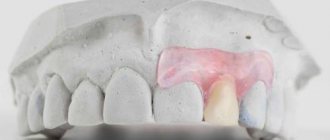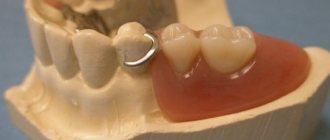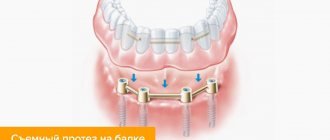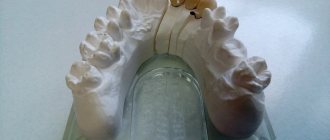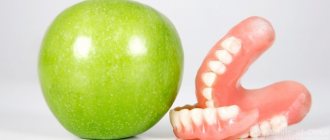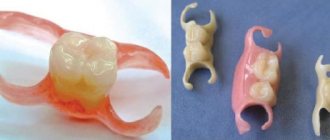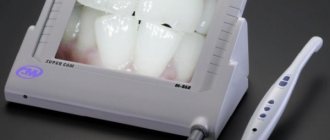Author of the article: Tsurkan Vladislav Gennadievich
Doctor-expert
Specialization: Dentist-orthopedist
Total work experience: since 2016
- Partially removable
Clasp
- QuattroTi
- Without sky
- Conditionally removable
- Which removable dentures are better?
With complete edentia
- With partial edentia
- For the upper jaw
- For the lower jaw
Restoring the dentition using removable dentures can be an alternative to fixed structures, especially when the latter have contraindications. To understand which type is suitable in your case, you need to know what removable dentures are available and how to choose the one that is best.
When is a removable partial denture placed?
Based on the name, you can understand that a partial removable dental prosthesis imitates a fragment of the dentition. This design can replace several missing teeth in a row or teeth lost in different areas of the jaw. Depending on this factor, the shape and size of the structure itself changes. In general, all types of removable dentures are united by a number of solutions. The base of a partial removable denture imitates soft tissues and part of the palate (if installed on the upper jaw). The boundaries of the prosthesis are clearly defined, since otherwise it would rest on the inner part of the base of the lips and would be unsuitable for wear. Artificial teeth made of plastic are installed in the base, which replace the crown part of missing natural teeth. In general, the design is quite simple, but this is precisely what makes this product so popular and widespread. There are a variety of materials used to make partial dentures, but some of them (for example, plastic) can cause allergic reactions.
When installed - indications and contraindications for prosthetics
| Indications | Contraindications |
| missing several teeth in a row | mental disorders |
| loss of chewing teeth on one or both sides | traumatic activities |
| contraindications to implantation | intolerance to the material |
| contraindications for bridge installation | dental problems of infectious-inflammatory nature |
| temporary replacement of lost teeth | periodontal diseases |
Types of partial dentures
Despite the fact that most removable dentures are very similar, experts divide them into several types. The main parameters are the number of teeth to be replaced and the material of manufacture.
Butterfly prosthesis
So named because of its shape, which resembles the wings of a butterfly. In most cases, a butterfly denture is installed when 1–2 teeth are missing in a row.
Partial removable clasp denture
A design that has an all-metal frame. Due to the metal arch, the clasp denture looks compact, but is less aesthetically pleasing than metal-free structures. In addition, metal can cause an allergic reaction.
Partial removable laminar denture
A removable lamellar prosthesis does not contain metal parts (fastening elements can be made of metal) and, in comparison with clasp structures, has a wider soft base.
Partial removable plastic denture
It is the cheapest design, which is often used as a temporary measure (for example, after implantation). A prosthesis made of acrylic plastic has the necessary rigidity, but is less comfortable than softer systems and can cause allergies.
Removable nylon partial dentures
Modern, comfortable and soft nylon prostheses, which, however, are significantly more expensive than plastic structures.
Immediate dentures
Removable immediate dentures - to replace defects in the dentition during the production of a permanent orthopedic system. There are three types of such models - full, partial, butterfly.
They cope with the task, return partial work to a lost dental unit and hide a visual defect. The disadvantages include fragility, fragility, and long addiction.
Partial removable denture for the upper and lower jaw
If we compare partial and complete removable dentures, then complete structures for the upper and lower jaws have very noticeable differences. For example, in the absence of all the teeth in the lower jaw, the prosthesis, in fact, rests only on the alveolar processes, which cannot be called a reliable fixation. Partial dentures are placed on natural teeth, so there are fewer problems with attachment. The upper partial denture has an artificial palate, which provides additional stability. However, thanks to clasps or attachments, the prosthesis is also very stable.
Examples of prostheses made in our laboratory
Thermoplastic (clasp) "Quattroti".
ACRY FREE (acrylic free).
Nylon removable denture.
The article was checked by: Meleshkin Dmitry Vladimirovich
If you liked this post, share it with your friends and subscribers.
Manufacturing of removable dentures
Prosthetics with various types of dentures has been used in clinical practice for decades, so dentistry has a well-functioning production mechanism.
Stages of manufacturing a partial removable denture
- Initial consultation, examination of the oral cavity and selection of orthopedic design.
- Taking impressions and producing a wax model in the laboratory.
- Grinding and correction of the finished structure.
- Finishing the structure in the articulator and trying on the wax structure by the patient.
Although the production of a partial denture takes on average 2 weeks, the adjustment period can last up to a month. At this time, the patient may feel some discomfort, but if the prosthesis causes significant pain and discomfort, it is worth contacting a specialist for correction or replacement of the structure.
Advantages and disadvantages
Advantages
- Restoring the aesthetics and functioning of the dentition;
- used in complex clinical situations when reconstruction methods are impossible;
- selection of types of orthopedic products;
- installation without preliminary grinding of abutment teeth;
- variability of materials for manufacturing;
- without restrictions;
- speed of production and installation;
- repair of the orthopedic system in case of mechanical damage;
- ease of wearing and care;
- exceptional hygiene and safety;
- no age restrictions;
- use as a temporary prosthetic structure;
- service life (5-8 years);
- preservation of aesthetic indicators;
- price.
Flaws
- Restoration of chewing function is not complete;
- changes in diction, taste sensitivity during the period of adaptation;
- the likelihood of gum inflammation, irritation of the oral mucosa;
- uneven distribution of chewing loads;
- unable to stop or prevent jawbone atrophy;
- not all types of dentures and fixtures can be repaired;
- risk of damage to tooth enamel, development of cervical caries in the area where the attachments adhere to the supporting ones;
- relatively long period of adaptation;
- deformation and subsidence of the product (for metal-free structures);
- insufficient fastening on the lower jaw (applies to complete removable dentures).
Fixation and stabilization of partial dentures
Methods for fixing partial removable dentures have remained unchanged over the past 10 to 20 years, i.e., since the advent of modern plate dentures.
| Fixation method | Description |
| Clasps | Metal or silicone hooks that fit around natural teeth and secure the denture in the mouth. |
| Attachmen | Micro-locks are installed on the supporting teeth, which snap into place upon contact with the structure. |
| Telescopic crowns | They are considered a very complex structure. The natural tooth is prepared and a special metal cap is put on it, after which a clasp prosthesis with grooves for fastening is installed. |
The most frequently asked questions about partial dentures
Is an allergy possible? How long does it take to get used to? Do you need fixing gels when wearing? You can find out the answers to these and other most popular questions in this section of the article.
— Is it possible to have an allergic reaction?
Is it possible. As a rule, an allergy can occur to acrylic when wearing plate dentures. Or on metal if wearing a clasp design. Before installing a prosthesis, a doctor may recommend that particularly sensitive people undergo a special test for sensitivity to materials.
— How long does it take to get used to it?
Sometimes it can take up to 3-4 weeks to get used to it. This usually applies to plate dentures, since they are more noticeable in the oral cavity. Clasp designs do not require so much time.
— Do I need to use fixing gels when wearing partial structures?
Partial structures do not require additional fixation, since they already have fastenings (hooks or clasps).
— Do I need to take off my dentures at night?
It is not at all necessary to remove the structure at night. It is not even recommended to remove the prosthesis for the first 3-4 weeks after installation, since there is an adaptation period. Further, at the discretion of the patient.
— Are there any restrictions when wearing?
Avoid eating excessively hard foods such as nuts or ice. It is also not recommended to eat foods that are too viscous and stick to artificial teeth.
Pros and cons of partial dentures
Partial dentures have a number of pros and cons. This is an ideal option for temporary prosthetics. However, if implantation is possible, you definitely do not need a removable denture. In any case, it doesn't hurt to know which partial dentures are best. Elastic (but not too soft) designs made from hypoallergenic materials are considered to be of the highest quality. In case of partial absence of teeth, removable laminar dentures made of nylon and acrylic-free plastic are the optimal solution.
- Low price.
- Acceptable functionality and aesthetics.
- Fast production.
- Easy hygiene.
- They do not load the bone, which is why the bone tissue decreases.
- Fragility and fragility (the circuit prosthesis lasts a maximum of 5 years).
- Difficulty getting used to it.
Caring for nylon dentures
Caring for removable nylon structures is quite simple.
- It is necessary to clean the denture daily with a special cleaning agent. The finished product in liquid form can be purchased at a pharmacy or diluted with water if it is sold in powder form. Often, this type of cleaning can be done by simply placing the removable structure in the solution overnight.
- As for daytime care, after eating it is enough to remove and treat the prosthesis with a special solution and a manual brush. When this is not possible, rinsing with ordinary water from a filter or after boiling is suitable. You can also clean dentures in the mouth with a regular toothbrush, but in this case you will have to switch to a special toothpaste.
How much do partial dentures cost?
The cost of partial dentures depends on several factors, the main ones being the number of teeth being restored and the material used.
| View | Price |
| Butterfly prosthesis | From 3,000 rubles |
| Plastic partial denture | From 7,000 rubles |
| Clasp prosthesis | From 25,000 rubles (with clasps) From 35,000 rubles (with attachments) From 80,000 rubles (with telescopic crowns) |
| Nylon prosthesis “Quadrotti” | From 37,000 rubles |
| Prosthesis "Acry Free" | From 35,000 rubles |
How to choose the best option
| Properties | Acrylic | Nylon | Akri-Free | Byugelny | Quadrotti | Sandwich | Butterfly |
| Aesthetics | average | high | high | relative | high | high | average |
| Strength | low | low | high | high | high | high | low |
| Allergy risk | There is | No | No | There is | No | There is | There is |
| Fixation | bad | bad | average | very good | good | good | bad |
| Comfort | short | short | high | average | high | average | average |
| Repair | available | not possible | available | available | available | available | available |
| Turning supports | not always | need not | need not | not always | need not | need not | need not |
| Service life (years) | 3-4 | 1,5-3 | 7-10 | 5-7 | 5-7 | 5-7 | 1-18 months |
| Price | low | low | average | high | high | high | low |
Stages and timing of dental prosthetics
The specific plan and order of all dental prosthetic measures in each individual case may be different, depending on which teeth are to be restored, what technology is chosen, etc. Any procedure always begins with an examination of the patient, assessment of the condition of the dentition and the necessary diagnostic procedures.
After this, the doctor, together with the patient, develops a detailed treatment plan. The stages of dental prosthetics may include grinding down teeth - to install veneers or crowns, or to fix a bridge or clasp prosthesis. Another important stage is taking impressions, from which the dental technician will make crowns or dentures.
The accuracy of the fit of the prosthesis and the ease of use in the future depend on the quality and accuracy of this procedure and the choice of the most suitable material. In order for everything to be done with the utmost precision, jaw modeling programs are used, the work of the jaw joints and muscles is revealed, and the closure of the teeth of the upper and lower rows is studied.
A mandatory stage of the dental prosthetics process is the manufacture of the prosthesis in the laboratory. This is labor-intensive jewelry work, the quality of which determines how successful the fitting of the design will be, whether adjustment is needed, how comfortable the use of the prosthesis will be for the patient, how quickly one can get used to it and how long the system will last.
After the prosthesis is made, it is tried on, modified if necessary, and then fixed. Very often, before installing a permanent option, which may take several months, the patient is given temporary structures, which will need to be dismantled before installing a permanent structure. And finally, after installation of the prosthesis, there is an adaptation period.
In the case of prosthetics on implants and installation of anatomically accurate structures, adaptation takes a matter of days. When installing complex and removable bridges, getting used to it can take a month. In general, it is simply impossible to say in advance how long prosthetics will take. This can only be determined by a doctor after examining a particular patient and choosing the surgical technology.
Preparing teeth for the procedure
Before the procedure, it is necessary to carry out a number of activities, which can take from one to several months. In particular, you will need to carry out professional oral hygiene and cure all your teeth. It may then be necessary to remove non-restorable teeth and their roots, and sometimes also to correct the bite or position of the teeth using braces.
If implantation is planned, it may require bone grafting. Therapeutic preparation of teeth for prosthetics includes complete sanitation of the oral cavity - professional cleaning, removal of tartar, treatment of caries and periodontitis, depulpation of those teeth that cannot be cured in any other way and those that are intended for grinding to fix dentures.
The surgical preparation stage involves the removal of severely damaged and incurable teeth, removal of soft and hard tissue pathologies, bone augmentation before implantation (for example, sinus lift), as well as the implantation operation itself. The orthodontic and orthopedic stages involve correcting the bite and straightening the teeth using braces.
This is important not only for beauty, but also to ensure that the load after installation of the prosthesis is distributed evenly - the health of the remaining teeth and the service life of the prosthesis depend on this. Protruding teeth are also sharpened and secondary deformities are corrected. All stages of preparation are extremely important and directly affect the quality of the procedure, ease of use of the prosthesis and its durability.
Selecting a method
Which dental prosthetics to choose in a particular case is determined by the nature and scale of dental defects - how many and what teeth are missing, how healthy the existing teeth are and what methods need to be used for their treatment and restoration. This will also require the necessary diagnostics - x-rays, tomography, laboratory tests, studying the patient’s health status.
Of course, the patient’s requirements play an important role - what result is needed and what financial capabilities he has. Some patients are willing to wait several months, while others need urgent prosthetics. Some agree to implantation, while others are contraindicated for medical reasons. In each specific case, the choice of technique and procedure plan is a compromise between desires and capabilities.
How are dentures made?
The manufacture of the prosthesis itself does not greatly affect the time of dental prosthetics - it takes only a few days. Much more time is spent on preparatory procedures, waiting for implants to heal, and adaptation to the finished structure.
After impressions are made and digital 3D models of the jaw are created, the impressions are transferred to plaster casts in the dental laboratory. Subsequently, structures made of titanium, zirconium dioxide, various alloys, and polymer materials are created using special equipment. Ceramic crowns require firing and sometimes painting. Installation of a finished structure
The manufactured prosthesis must be tried on. If the fit is incomplete or inaccurate, the doctor corrects it or sends it to the laboratory. If it fits perfectly, the doctor fixes it in the oral cavity. Correction may be required in the future due to changes in the tone of the masticatory muscles, malocclusion, and bone tissue atrophy due to the lack of chewing load on the bone.
Next, the doctor instructs the patient how to use the denture - what can be chewed and what cannot, how often and thoroughly should be cleaned, when to come for an appointment to inspect the structure, professional cleaning, and, if necessary, repair or replace components.
How are dentures attached if the last supporting teeth are missing?
If we mean a complete absence of teeth, then various types of complete prosthetics, which we discussed above, are suitable. If the teeth are preserved, for example, in front and we are only talking about restoring the lateral chewing teeth, then it is possible either clasp prosthetics on implants (which will provide the necessary support for the prosthesis), or the installation of removable dentures made of acrylic or nylon, or clasp prosthetics with support on the front ones teeth.
How to quickly get used to a removable prosthetic system?
After installing a denture, it will take time to get used to it. To ensure that adaptation proceeds without problems, we recommend:
- Do not remove from mouth for long;
- suck on lollipops to suppress the feeling of nausea;
- read aloud to practice clear diction;
- For the first few days, follow a gentle diet.
Addiction lasts on average 2-4 weeks. If discomfort persists for more than a month, pain intensifies, gums become inflamed and bleed, you should consult a doctor.
Clasp structures supported by implants
Due to the fact that clasp prosthetics requires support, in the case of complete edentia, the clasp can be installed only after implantation. Thanks to the metal frame in the form of an arc, strength and uniform distribution of the load when chewing are ensured. Artificial teeth and a plastic base that imitates gums are attached to the frame. There are several types of fastening: hooks, clasps and crowns.
The “All-on-4x” design is also a variant of the clasp on implants.
